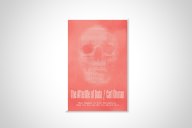You have /5 articles left.
Sign up for a free account or log in.
"[A] good read for a sociology major, but all others should avoid it," warns a one-star review on Amazon of Jeffrey Melnick's Creepy Crawling: Charles Manson and the Many Lives of America's Most Infamous Family (Arcade Publishing). It happens I think the potential audience of interested readers is much larger than that, although even the author must grant that the grounds for that assessment come packaged with the book's status as a trade book -- a cultural commodity intended for a market geared to known tastes.
Most readers will want blood and new details. A little cultural analysis around the edges of the crime scene is permissible, even necessary; the context and dynamics of a mutant hippie enclave take some explaining. But Melnick, who is a professor of American studies at the University of Massachusetts Boston, reverses the proportions. He is perfectly forthright about it: "I am not interested in the crime itself, and this is not a true crime book in any conventional sense." Nor is he enraptured by the morbid charisma of Manson himself. The book directs no attention to Manson's song lyrics or to those "I am but the reflection and scapegoat of a society that is truly insane!"-themed harangues that enlivened his parole hearings over the years.
So what does that leave to discuss? Quite a lot, in fact. The array of forms taken by the Manson obsession is huge, diverse and multimedia. The bulk of it accumulated well after the crimes had disappeared from the headlines. The cultural archive includes memoirs, novels, documentaries, docudramas, horror films, art installations, true-crime paperbacks, television programs of varying degrees of trashiness, recordings of Manson's songs, covers of those songs by other artists, an opera or two, transgressive punk gestures (including at least two bands called Sharon Tate's Baby), a surprising number of hip-hop homages and enough rumors and legends to amount to a kind of folklore. This list is not exhaustive. An element of sensationalism is undeniable but hardly suffices to explain what Melnick calls "the remarkably robust afterlife of the Manson Family."
Woodstock and the Tate-LaBianca murders took place within days of one another in August 1969, and it long ago became a commonplace to think of them as, respectively, the culmination and the bloody collapse of the decade's counterculture. Creepy Crawling distances itself from the whole "Manson killed the '60s" theme as much and as often as possible and instead tries to launch a different trope. The book takes its title from a Family activity -- part prank, part ritual -- that Melnick treats as a metaphor for Manson and friends' cultural impact, both at the time and over the long term. Going out on a "creepy crawl" involved "breaking and entering into a private home," he writes, "rearranging furniture, perhaps having a quick snack, and then leaving without, usually, taking anything." While nonviolent, the practice looks in retrospect like a dry run for the Tate-LaBianca murders. Melnick instead focuses on it as "the upsetting flipside" of a more commonplace hippie practice, dumpster diving.
If the Manson Family was able to develop a sustainable model of food production by making something out of nothing (i.e., meals from what most Americans would call garbage), it was also intent on underscoring the emptiness at the heart of rampant materialism by leaving "valuable" objects behind when they were ripe for the picking.
The creepy crawls took place amid plenty of breached norms and upended hierarchies -- or at least a good deal of playing at such transvaluations. Manson's exploitation of the Family (young hippie runaways, for the most part) as sexual barter to develop connections with a number of rock stars and celebrity hangers-on is well known. Likewise his mounting rage by early 1969 at not being able to secure a recording contract -- a prospect often taken to have been as delusional as his conviction that the Beatles were sending him coded messages through songs on The White Album.
But Melnick complicates that picture by focusing at some length on "the hip aristocracy of Los Angeles’s culture industries [that] dallied with emerging figures from the margins" in the mid- to late-1960s. They included "an emerging new class of film-world entrepreneurs who liked to present themselves as anti-authoritarian and countercultural," such as Peter Fonda and Dennis Hopper. (Not only did they play bikers on-screen, but they also scored from them in real life. Or at least sent someone with the cash.) This demimonde included musicians, of course, as well as movie- and recording-industry personnel. "One could be a hippie and not only want power but actually have power," as Melnick puts it.
Charlie's power, such as it was, came from playing mind games with his followers using principles acquired from studying L. Ron Hubbard and Dale Carnegie in prison. He could also improvise stream-of-consciousness lyrics while performing. Neil Young (whose seldom-performed song "Revolution Blues" is unmistakably about Manson) thought he showed promise. Sociopathy is no obstacle to success in life, and Manson's expectation of joining the ranks of singer-songwriters was not wholly unreasonable. "The Manson Family’s interaction with the new elite of Los Angeles," Melnick concludes, "can be best understood as a failed set of experiments aimed at erasing profound differences in class status and access to cultural capital."
The key word here is, of course, "failed." The slaughter that followed barely makes sense as revenge, even factoring in the bizarre apocalyptic race-war scenario that the prosecutor, Vincent Bugliosi, presented at trial and elaborated on in Helter Skelter (1974). True to the author's word, Creepy Crawling neither challenges Bugliosi's theory of the case nor offers one of his own; even so, Helter Skelter looms over Melnick's cultural history from start to finish. He presents the first few years after the murders as a period when every last connection between the Beautiful People and the dirty hippies was severed and denied, or at very least worked through in therapy.
For Melnick, Helter Skelter is in part an effort to downplay those contacts: "If Manson had rearranged some of the furniture of the Los Angeles’s cultural scene, then it was going to be Bugliosi’s job to get the house back in order." And he did so in a way that lent itself to retailing as a story of pure evil being defeated by heroism -- Bugliosi's own. Manson as bloodthirsty Pied Piper dominated the story, making it easier to ignore the fragility of the nuclear family, with its sometimes incestuous secrets, that had created a generation of runaways. Maybe conformity to norms wasn't such a bad idea after all. Say what you will about the Establishment, but it doesn't encourage young women to shave off all their hair and cut an X into their foreheads.
Much of the popular culture fixated on Manson duly followed this return-to-normalcy script. In time, a kind of sinister parody of it emerged: a flirtation with Manson imagery, a celebration of Family values, transgression on the cheap (e.g.: Sonic Youth's "Death Valley '69"). Some of the fiction Melnick discusses probes more deeply into the lives of Manson's disciples -- some of them complicit but also broken. The same is true of John Moran's The Manson Family: An Opera, unfortunately neglected by Melnick. Especially powerful is a sequence presenting one of Charlie's mind-melting rants and then taking the audience into the drugged, trapped inner voice of a follower, struggling to keep some sense of personal identity. The range of cultural creativity inspired by the Manson Family is fascinating to read about and disturbing to imagine, though not nearly so troubling as the thought of having his voice creepy crawling around in your brain.








